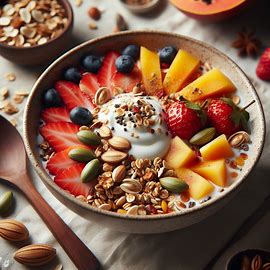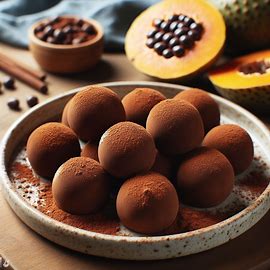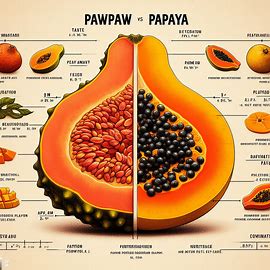Pawpaws: A Unique North American Fruit
Introduction
Pawpaws (Asimina triloba) are a tasty tree fruit native to eastern North America. Often described as a mix of banana, mango, and vanilla custard flavors, pawpaws offer a one-of-a-kind sensory and nutritional experience. Read on to learn all about these exotic-tasting fruits.
Origins and Appearance
Pawpaws grow on small, deciduous trees found in the eastern U.S. from northern Florida to southern Ontario. Pawpaw fruits resemble short, fat bananas, with green skin that blackens as it ripens. Inside, the creamy yellow flesh hides rows of large, easy-to-remove black seeds.
Flavor, Texture and Uses
Ripe, raw pawpaw pulp tastes tropical, smooth and sweet with notes of melon, banana and vanilla. The rich, custard-like texture lends itself to chilled desserts like ice cream, smoothies or mousse. Gentle cooking retains the delicate flavor, allowing it to shine in everything from quick breads to jams.
Nutrition and Health Benefits
Per 100 grams, raw pawpaw delivers 80 calories, 2 grams fiber and 20% of vitamin C daily needs [(1)]. It also boasts high antioxidant levels from polyphenols like flavonoids [(2)]. These compounds likely support the fruit’s traditional medicinal uses for gut health and anti-parasitic, anti-cancer and anti-inflammatory effects [(3)]. However, human trials are still needed.
Pawpaw seeds also tout digestive enzymes and antioxidant, anti-parasitic potential [(4)]. But their bitter taste and possible toxicity in excess make moderation key.
Benefits of Pawpaws:
- Pawpaws are nutritious, rich in vitamins and minerals, especially vitamin C, magnesium, manganese, and iron.
- They contain plant compounds with potential antioxidant and anti-inflammatory effects.
Digestive:
- Papain enzyme: Similar to papaya flesh, pawpaw seeds contain papain, which aids digestion and can potentially relieve constipation.
- Fiber: Rich in fiber, promoting gut health and regularity.
Antioxidant:
- Annonacin: This unique compound shows potential antioxidant and anti-inflammatory properties, but needs further study.
- Other antioxidants: Rich in phenolic compounds and flavonoids, providing antioxidant protection against free radical damage.
Other potential benefits:
- Parasitic: Traditionally used against intestinal parasites, but conclusive scientific evidence is lacking.
- Anti-cancer: Annonacin shows promise in laboratory studies, but research on human effectiveness is needed.
- Menstrual pain relief: Traditional use claims pain relief, but scientific evidence is lacking.
- Fertility boost: Traditional use claims fertility support, but scientific evidence is lacking.
- Detoxification: Traditional use suggests detoxification properties, but scientific evidence is lacking.
Nutrient Profile
Per 100 grams, pawpaws and papayas are neck-and-neck for fiber, vitamin C and magnesium content. However, pawpaws contain 40% more iron. They also edge out papayas in calcium, potassium and vitamins A and B6 [(1), (2)]. Both fruits tout high levels of antioxidant polyphenols, though pawpaws boast the added benefit of antioxidants like flavonoids [(3)]. These compounds support traditional medicinal uses for improved immunity, digestion, anti-parasitic effects and more [(4)].
| Nutrient | Pawpaw | Papaya | Winner |
|---|---|---|---|
| Vitamin C | 20% DV | 188% DV | Papaya 👑 |
| Vitamin A | 5% DV | 31% DV | Papaya 👑 |
| Potassium | 7% DV | 7% DV | Tie 🤝 |
| Iron | 8% DV | 5% DV | Pawpaw 👑 |
Availability and Ripening
Currently, pawpaws remain scarce in supermarkets due to highly limited commercial production and a short, temperamental ripening window. However, you may find them at farmers markets or grow your own pawpaw tree. Choose fragrant fruits that yield slightly to gentle pressure. Then store at room temp until completely soft and fragrant.
So Should You Pawpaw?
With a one-of-a-kind flavor profile full of tropical notes, pawpaw offers a uniquely American culinary experience focused on sweet flavors. Pair that with an impressive nutrient and phytochemical profile, and pawpaw seems primed for superfruit status pending more research.
References:
- Kentucky State University Pawpaw Program
- Journal of Agricultural and Food Chemistry
- Comprehensive Reviews in Food Science and Food Safety
- Journal of Ethnopharmacology
Pawpaw vs Papaya: A Comparative Analysis
At first glance, pawpaws and papayas appear strikingly similar – sweet, golden-fleshed tropical fruits packed with nutrients and bold flavors. However, despite the visual resemblance, these fruits belong to entirely different botanical families and offer unique sensory experiences and health benefits.
This article provides an in-depth comparative analysis of pawpaws and papayas, including their origins, culinary qualities, nutritional content, medicinal properties, and more. Read on to discover what makes each fruit special.
Origins and Growing Conditions
Pawpaws belong to the Annonaceae family that also includes cherimoya, soursop, and ylang-ylang. They grow on small, deciduous trees native to the eastern United States and southern Ontario/Quebec areas. Pawpaws thrive in zones 5-9.
In contrast, papayas belong to Caricaceae, their own unique plant family. They originate from southern Mexico and Central America. Papayas grow on fast-growing trees that require tropical or subtropical climates, generally zones 9-11.
So while they look alike, pawpaws and papayas hail from different families and continents!
Appearance, Taste and Texture
Pawpaws ripen from green to a golden yellow or brown hue, often with splotchy skin. The rich yellow flesh hides numerous large, easy-to-remove black seeds. Ripe pawpaws offer a sweet, creamy texture reminiscent of custard or banana pudding. Notes of vanilla, banana, pineapple, and mango create a truly tropical eating experience.
Papayas typically ripen from green to vibrant orange or yellow. Their smooth skin and firmer golden flesh conceal small, peppery black seeds. When ripe, papayas taste intensely sweet and fruity, with dominant notes of apricot, cantaloupe, and honey rather than pawpaw’s more complex flavor.
So both fruits look vaguely similar externally but differ significantly in flavor and texture!
Nutrient and Phytochemical Profile
Per 100 grams, pawpaws offer 80 calories, around 2 grams fiber and 20% daily vitamin C. They also deliver generous amounts of magnesium, iron, potassium, vitamins A and B6 [(1)]. Unique phytochemicals like flavonoids give pawpaws high antioxidant capacity with biological activity that warrants more research [(2)].
In comparison, papayas contain only 60 calories but feature over 200% vitamin C and 30% vitamin A per 100 grams. They also pack significant vitamin B, potassium and fiber content with phytochemicals like lycopene and carotenoids. However, pawpaws edge out papayas for magnesium, calcium, vitamins B6 and E [(3)].
So while both fruits boast high nutrition, pawpaws offer more diverse vitamin and mineral support compared to papayas. However, papayas contain significantly more immunity-boosting vitamin C.
Medicinal Properties and Health Effects
Thanks to their nutrition and phytochemicals, both fruits display potential medicinal properties:
Pawpaws tout digestive enzymes like papain, antioxidant and anti-inflammatory action from flavonoids like anthocyanins, and antibacterial, anti-parasitic abilities from compounds like acetogenins [(4)]. Pawpaw seed extracts may even suppress tumor cell growth in vitro [(5)].
Papayas also feature papain and other digestive enzymes like chymopapain. Compounds like lycopene and carotenoids give papayas antioxidant, anti-inflammatory, cardio-protective, and immune-modulating effects along with wound healing potential [(6)].
However, more high quality studies in humans are needed to substantiate many assumed health benefits for both produce items.
So while preliminary research shows promising medicinal applications, scientists still have much to learn about these fruits’ biological effects.
Culinary Uses
The smooth, delicate texture of ripe pawpaws makes them ideal for chilled raw preparations like smoothies, ice cream, and fruit salads. Gentle baking or light cooking retains their flavor for integration into quick breads, puddings, jam, or even craft beer.
In contrast, papayas hold up better to heating for hot applications like chutneys, salsa, Thai curries, or glazes for meat and poultry. Blend them into tropical juices and smoothies or simply enjoy fresh. The firmer flesh stands up well in fruit salads too.
So pawpaws function better as a gentle ingredient accent in chilled items, while papayas shine as a star component in cooked dishes.
Availability & Storage
Lack of commercial production means fresh pawpaws mainly pop up at farmers markets or in home growers’ yards during their September ripeness peak. They also freeze well for longer term storage. Select aromatic, yellow-green fruits that yield slightly to pressure. Then store ripening pawpaws at room temperature.
In contrast, most major grocery stores carry papayas year-round since they grow more prolifically in tropical areas ideal for cultivation. Choose fragrant fruits becoming yellow with resilient flesh. Let them finish ripening on the counter before storing ripe papayas in the refrigerator.
So papayas definitely win out when it comes to accessibility and storage!
The Verdict
While pawpaws and papayas share a similar appearance and sweet flavor, they boast totally unique developmental histories and nutritional profiles. As rising interest boosts cultivation of once neglected pawpaws, Americans can now enjoy the best of both worlds between this hearty native fruit and tropical papayas. Their diversity lends uniqueness to menus while providing a cornucopia of vital nutrients and intriguing phytochemicals.
In the battle between these two nutritional titans, everyone wins by enjoying their distinct flavors and health benefits alike. The competition ultimately yields more options for healthy, sustainable fruit consumption – and that’s something to smile about.
Unlocking Pawpaw Powerhouses: Your Guide to Using Pawpaw Seeds
Pawpaw fruits offer a sweet nutritional boost come autumn foraging season. But rather than tossing those abundant seeds, why not tap into their next-level nutrition and bold flavor?
Discover methods for extracting seed nutrients to maximize digestive absorption. Then put those toasted, zesty gems of protein and fiber to work through tempting recipes like Powered-Up Pesto, Salad Sprinkles, and Pawpaw Pan Bread.
Savoring the Seeds: While the benefits are alluring, moderation is key. Here’s how to unleash the potential of pawpaw seeds safely and deliciously:
- Spice up your dishes: Grind dried seeds into a powder for a unique, peppery spice in dips, stews, or salad dressings. Start small and adjust to your taste preference.
- Whirl up a vibrant pesto: Blend crushed seeds with fresh herbs, olive oil, and lemon juice for a zesty pesto to top pasta, grilled vegetables, or spread on sandwiches.
- Unlock subtle flavors in drinks: Add a few crushed seeds to water, tea, or kombucha for a hint of flavor and potential antioxidant benefits.
- Bake with a twist: Infuse muffins, cookies, or granola bars with ground seeds for a unique and nutritious twist. Remember, moderation is key!
- Roast for a crunchy snack: Toss seeds with olive oil and spices, then roast them for a healthy and flavorful treat. Limit the quantity due to potential risks of excessive consumption.
Recipes to Ignite Your Culinary Creativity:
- Pawpaw Seed Smoothie: Blend 1 cup of pawpaw seeds, 2 cups of water, 1 banana, and 1 tablespoon of honey for a refreshing and antioxidant-rich smoothie.
- Pawpaw Seed Salad Dressing: Grind 1/4 cup of pawpaw seeds and mix with 1/2 cup of olive oil, 1/4 cup of apple cider vinegar, 1 tablespoon of honey, salt, and pepper. Enjoy a vibrant and flavorful dressing on your salad.
- Pawpaw Seed Tea: Boil 1 cup of water, add 1 tablespoon of pawpaw seeds, steep for 10 minutes, and strain. Add honey or lemon juice to taste for a relaxing and potentially beneficial tea.
- Pawpaw Seed Curry: Grind 1/2 cup of pawpaw seeds with curry powder, salt, and water. Cook in oil for 5 minutes and serve with rice or bread for a unique and flavorful curry.
- Pawpaw Seed Granola: Infuse your homemade granola with a small amount of ground pawpaw seeds for a unique nutty and antioxidant boost.
Important Warnings:
- Annonacin Toxicity: Toxic in high doses; excessive consumption not recommended.
- Bitter Taste: Unpleasant taste for some individuals.
- Limited Research: Reported benefits based on traditional uses or preliminary research; more studies needed.
Remember:
- Always prioritize moderation when consuming pawpaw seeds.
- Consult a healthcare professional before incorporating them into your diet if you have any health concerns.
- Enjoy the delicious flesh of pawpaw as the primary way to benefit from this fruit.










